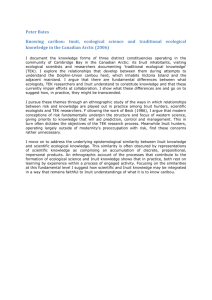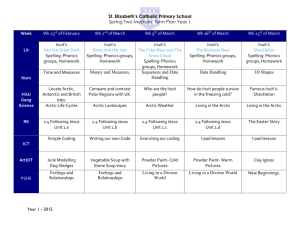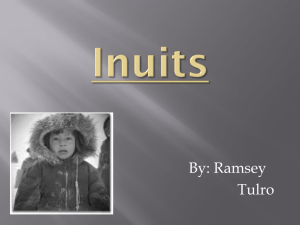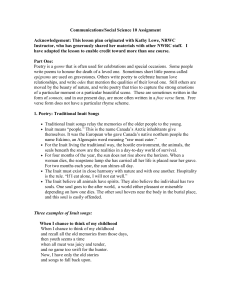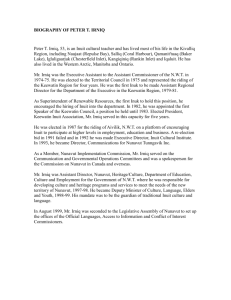The Yoruba - Mythic Journeys
advertisement
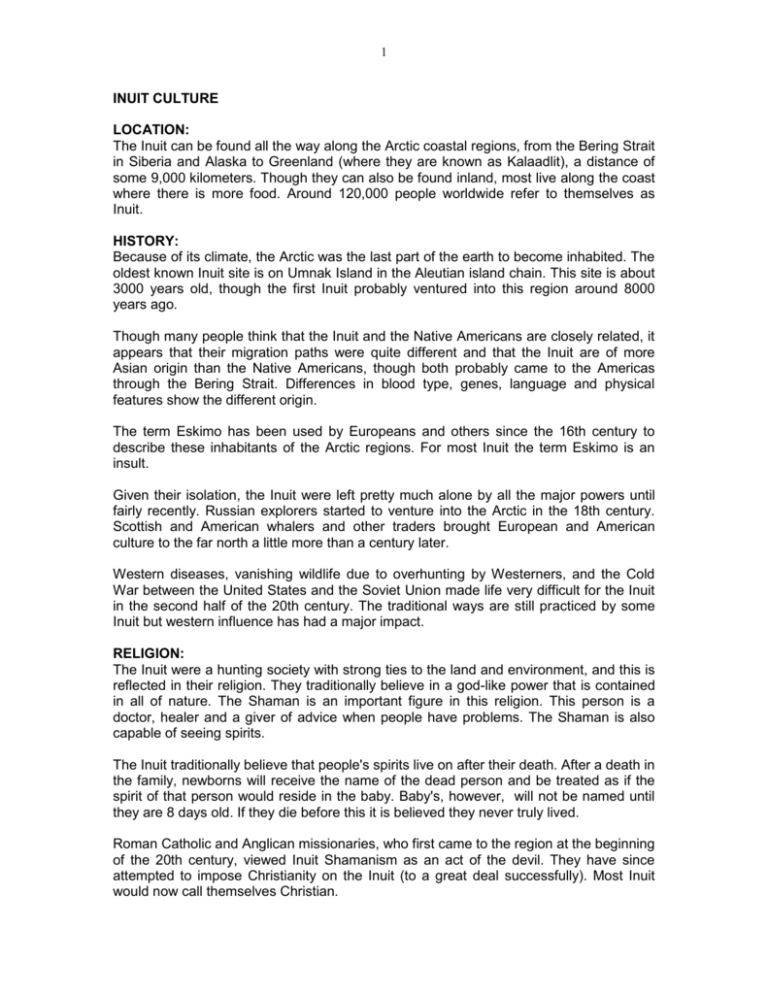
1 INUIT CULTURE LOCATION: The Inuit can be found all the way along the Arctic coastal regions, from the Bering Strait in Siberia and Alaska to Greenland (where they are known as Kalaadlit), a distance of some 9,000 kilometers. Though they can also be found inland, most live along the coast where there is more food. Around 120,000 people worldwide refer to themselves as Inuit. HISTORY: Because of its climate, the Arctic was the last part of the earth to become inhabited. The oldest known Inuit site is on Umnak Island in the Aleutian island chain. This site is about 3000 years old, though the first Inuit probably ventured into this region around 8000 years ago. Though many people think that the Inuit and the Native Americans are closely related, it appears that their migration paths were quite different and that the Inuit are of more Asian origin than the Native Americans, though both probably came to the Americas through the Bering Strait. Differences in blood type, genes, language and physical features show the different origin. The term Eskimo has been used by Europeans and others since the 16th century to describe these inhabitants of the Arctic regions. For most Inuit the term Eskimo is an insult. Given their isolation, the Inuit were left pretty much alone by all the major powers until fairly recently. Russian explorers started to venture into the Arctic in the 18th century. Scottish and American whalers and other traders brought European and American culture to the far north a little more than a century later. Western diseases, vanishing wildlife due to overhunting by Westerners, and the Cold War between the United States and the Soviet Union made life very difficult for the Inuit in the second half of the 20th century. The traditional ways are still practiced by some Inuit but western influence has had a major impact. RELIGION: The Inuit were a hunting society with strong ties to the land and environment, and this is reflected in their religion. They traditionally believe in a god-like power that is contained in all of nature. The Shaman is an important figure in this religion. This person is a doctor, healer and a giver of advice when people have problems. The Shaman is also capable of seeing spirits. The Inuit traditionally believe that people's spirits live on after their death. After a death in the family, newborns will receive the name of the dead person and be treated as if the spirit of that person would reside in the baby. Baby's, however, will not be named until they are 8 days old. If they die before this it is believed they never truly lived. Roman Catholic and Anglican missionaries, who first came to the region at the beginning of the 20th century, viewed Inuit Shamanism as an act of the devil. They have since attempted to impose Christianity on the Inuit (to a great deal successfully). Most Inuit would now call themselves Christian. 2 SOCIETY, ECONOMY AND POLITICS: Hunting has been the cornerstone of Inuit society since they first came to the Arctic region, and has influenced the way society is structured. Hunting animals such as seals and caribou was done using harpoons and bow and arrow. Holes were made in the ice to catch seals, for instance. Today the rifle has replaced the harpoon and bow and arrow as a hunting tool for that keep the hunting tradition alive. The hunt is now often conducted with snowmobiles. Instead of hunting, many Inuit today have chosen to move into towns in order to work in mines and oil fields. Because of this most now live in permanent housing. CULTURE: Inuit culture is a reflection of the harsh environment in which the Inuit live. The Inuit were nomads, travelling from place to place, looking for that might offer more food as the seasons and fortunes changed. Almost no trees and few plants grow in the Arctic and therefore meat is the main source of food. Growing crops is almost impossible. Caribou, seal, birds, walrus, whale and fish have traditionally been hunted for their food value. Berries and seaweed are gathered in the summer to supplement a diet that is otherwise lacking vegetables. Eggs are also gathered in the short summer season. Caribou fur has always been an important material for clothing because it could keep people warm in sub-zero temperatures. Today, however, many Inuit wear thick down jackets to ward off the cold. Depending on the time of year the Inuit traditionally live in different dwellings. In the summer they have tended to live in tents made of animal skin. In the winter they tended to live in either igloos (houses made of snow blocks) or in houses half buried underneath the ground, made of stone, wood and whale bones. Sometimes, however, extra layers of skin were added to the summer tent, with plants in between the skin layers and snow on top of all this (insulation) for extra warmth. The Inuit language survives through storytelling. A song often goes with these stories, and many events are described in these songs. Many songs focus on hunting tales, especially telling of hardship during the hunt. Inuit art consisted in the past for the most part of decorating instruments such as spears, harpoons and pipes, and carving animals from soft soapstone. The Inuit are also known for the fact that when they greet each other they rub noses instead of shaking hands.


